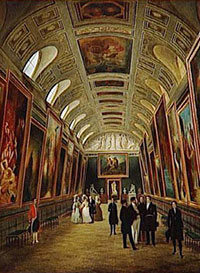At first located in the Luxembourg Palace, the Luxembourg Museum opened its doors to the public in 1750.
Visitors could admire the twenty-four Rubens paintings celebrating Marie de Medici and around a hundred paintings from the King's Cabinet by artists such as Leonardo da Vinci, Raphael, Veronese, Titian, Poussin, Van Dyck, and Rembrandt.
After these works were transferred to the Louvre, in 1818 the Luxembourg Museum became a "museum of living artists", that is to say, a contemporary art museum. Artworks by David, Ingres, Delacroix, and others were exhibited there.
Appointed as the administrator of the Palace and Luxembourg Garden in 1879, the Senate constructed the current building between 1884 and 1886. The Impressionists were exhibited here for the first time in a national museum, thanks to the Caillebotte bequest, which included works by Pissarro, Manet, Cézanne, Sisley, Monet, Renoir, and others. This collection is now housed at the Musée d'Orsay.
Closed after the construction of the National Museum of Modern Art at the Palais de Tokyo in 1937, the Luxembourg Museum reopened to the public in 1979. The Ministry of Culture organised exhibitions there on the heritage of the regions and the collections of provincial museums, with the Senate retaining oversight over programming and use of the building.

Louis-Philippe and Queen Maria-Amalia visiting the Luxembourg Museum in 1838
Auguste Jean Simon ROUX (Paris, 19th century)
A Museum Run by the Senate
In 2000, the Senate decided to assume full responsibility for the Luxembourg Museum once again, in order to conduct a coordinated cultural policy in the Palace, Garden, and Museum.
While its primary missions, as a parliamentary assembly, include the enactment of laws, government oversight, evaluation of public policies, and forward planning, the Senate is also tasked with showcasing the heritage it manages.
In order to ensure a wide reach and a high standard of excellence in the production and organisation of exhibitions, the Senate has chosen to delegate its management to professionals in the field.
Since then, the Luxembourg Museum has established itself as one of the main exhibition venues in Paris, allowing its many visitors to appreciate masterpieces by Botticelli, Raphael, Titian, Arcimboldo, Veronese, Gauguin, Matisse, Vlaminck, Modigliani, and more.
In 2010, the Senate delegated management of the museum to the Réunion des Musées Nationaux (National Museums Union), focusing on three programming themes related to its history: "the Renaissance in Europe", "Art and Power", and "the Palace, the Garden, and the Museum: Luxembourg at the Heart of Paris, the Capital of Arts."
The Réunion des Musées Nationaux is a recognised cultural operator and one of the leading organisers of exhibitions in the world. Its activities include exhibiting, publishing, distributing, acquiring, welcoming, and informing, thereby contributing to the enrichment and better understanding of artistic heritage both nationally and internationally.